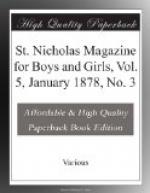Girls are always trying to find something which they can make to delight their papas, and a gay little pen-wiper with fresh uninked leaves rarely comes amiss to a man who likes an orderly writing-table. Here is a pretty one which is easily made. For the pattern you may borrow a moderately large beech-leaf from the nearest tree (or botanical work); lay it down on paper, pencil the outline and cut it out neatly. Repeat this six or eight times in black cloth or velvet, and sew the leaves round a small oval or circle of black cloth. Knit and ravel out a quantity of yellow worsted or floss silk, and with it construct a nest in the center of the oval, putting a hen into the nest. This hen may be made of canton flannel, stuffed with cotton-wool and painted in water color, with a comb of red flannel, two black beads for eyes, and a tuft of feathers by way of tail. But better still and much easier, buy one of the droll little Japanese chicks which can be had at the shops now for twenty or twenty-five cents, and fasten it in the middle of the nest. Three plain circles of cloth are fastened underneath for wiping the pens.
JAPANESE PEN-WIPER.
[Illustration: A JAPANESE PEN-WIPER.]
A nice little pen-wiper can be made by cutting three circles of black cloth, snipping the edges or button-holing them with colored silk, and standing in the middle one of the droll little Japanese birds just mentioned. Of course it should be secured firmly at the feet. There are long-legged birds and short-legged ones. A tiny stork is very pretty.
BLEACHED GRASSES.
Some of you who have been pressing autumn leaves for winter use may like to hear of a new way of bleaching grasses to mix with them. The process is exceedingly simple. Take a few of the grasses in your hand at a time, dip them into a pan of water, shake gently, dip into a pan of sifted flour, and again shake gently. All the superfluous flour will fall off, but enough will remain to make the grasses snowy-white. When dry it is perfectly firm, and you would never guess what process produced the effect. A bunch of these white grasses in a coral-red basket is a vivid object.
Colored grasses, to our thinking, are not half so pretty as the same grasses when left in their own soft natural browns and yellows. Still, as some people like them, we will just mention that the same process can be used for them as for the white grass, by mixing with small portions of flour, a little dry paint powder, vermilion, green, etc. A bunch of the deep red mixed with the bleached grass has a gay and uncommon effect.
A NUBE IN TWO COLORS.
A novelty in knitting is a nube in Shetland wool of two colors—pink or crimson or blue with white. The skeins are opened, and the two strands, laid side by side, are wound double in a large ball. The nube is then knit in the usual way with large needles and common garter-stitch, and is very fine.




